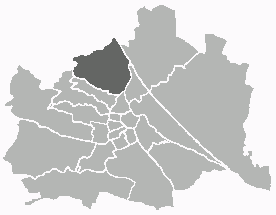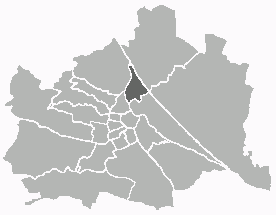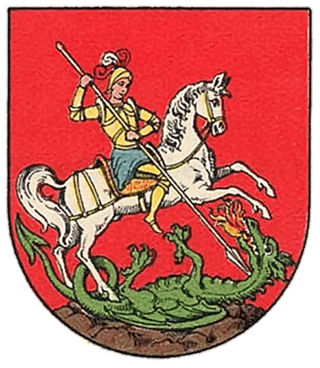
Simmering is the 11th district of Vienna, Austria. It borders the Danube and was established as a district in 1892. Simmering has several churches, some museums, schools, old castles, and four cemeteries, one of them being the Wiener Zentralfriedhof, one of the largest cemeteries of Europe.

The Rhine–Main–Danube Canal, is a canal in Bavaria, Germany. Connecting the Main and the Danube rivers across the European Watershed, it runs from Bamberg via Nuremberg to Kelheim. The canal connects the North Sea and Atlantic Ocean to the Black Sea, providing a navigable artery between the Rhine delta, and the Danube Delta in south-eastern Romania and south-western Ukraine. The present canal was completed in 1992 and is 171 kilometres (106 mi) long.

The Lobau is a Vienna floodplain on the northern side of the Danube in Donaustadt and partly in Großenzersdorf, Lower Austria. It has been part of the Danube-Auen National Park since 1996 and has been a protected area since 1978. It is used as a recreational area and is known as a site of nudism. There is also an oil harbour, and the Austrian Army used the Lobau as a training ground. In addition to the water coming from the Alps through the Wiener Hochquellenwasserleitung, the Lobau is a source of groundwater for Vienna.

The Donauinsel is a long, narrow artificial island in central Vienna, Austria, lying between the Danube river and the parallel excavated channel Neue Donau. The island is 21.1 km (13.1 mi) in length, but is only 70–210 m (230–689 ft) wide. It was constructed from 1972 to 1988 primarily as a measure for flood protection.

Döbling is the 19th district in the city of Vienna, Austria. It is located in the north of Vienna, north of the districts Alsergrund and Währing. Döbling has some heavily populated urban areas with many residential buildings, and borders the Vienna Woods. It includes some of the most expensive residential areas such as Grinzing, Sievering, and Neustift am Walde, and is home to many Heurigen taverns. There are some large Gemeindebauten, including Vienna's most famous, the Karl-Marx-Hof.

Donaustadt is the 22nd district of Vienna, Austria . Donaustadt is the eastern district of Vienna.

Brigittenau is the 20th district of Vienna. It is located north of the central districts, north of Leopoldstadt on the same island area between the Danube and the Danube Canal. Brigittenau is a heavily populated urban area with many residential buildings.

Donau-Auen National Park covers 93 square kilometres in Vienna and Lower Austria and is one of the largest remaining floodplains of the Danube in Middle Europe.

The Danube–Oder Canal is a planned and partially constructed artificial waterway in the Lobau floodplain of the Danube at Vienna, that was supposed to stretch along the Morava River to the Oder at the city of Kędzierzyn-Koźle in Poland.

Kahlenbergerdorf was an independent municipality until 1892 and is today a part of Döbling, the 19th district of Vienna. It is also one of the 89 Katastralgemeinden.

The Donaukanal is a former arm of the river Danube, now regulated as a water channel, within the city of Vienna, Austria. It is 17.3 kilometres (10.7 mi) long and, unlike the Danube itself, it borders Vienna's city centre, Innere Stadt, where the Wien River (Wienfluss) flows into it.

The Reichsbrücke is a major bridge in Vienna, linking Mexikoplatz in Leopoldstadt with the Donauinsel in Donaustadt across the Danube. The bridge is used by 50,000 vehicles per day and carries six lanes of traffic, U-Bahn tracks, two footpaths, two cyclepaths and two utility tunnels.

Donau City, or Vienna DC, is a new part of Vienna's 22nd District Donaustadt, next to both the Reichsbrücke and the left bank of the Danube's 21.1 km new channel, Neue Donau.

The Danube is the second-longest river in Europe, after the Volga in Russia. It flows through Central and Southeastern Europe, from the Black Forest south into the Black Sea. A large and historically important river, it was once a frontier of the Roman Empire. In the 21st century, it connects ten European countries, running through their territories or marking a border. Originating in Germany, the Danube flows southeast for 2,850 km (1,770 mi), passing through or bordering Austria, Slovakia, Hungary, Croatia, Serbia, Romania, Bulgaria, Moldova, and Ukraine. Among the many cities on the river are four national capitals: Vienna, Bratislava, Budapest, and Belgrade. Its drainage basin amounts to 817,000 km2 (315,000 sq mi) and extends into nine more countries.
The Schwimmtor, also known as the Sperrschiff, was a floating barrier designed to protect the areas along the Donaukanal in Vienna from flooding and ice. It was built by Wilhelm von Engerth, entered service on 13 December 1873, and was scrapped following World War II.

The Nussdorf weir and lock are works of hydraulic engineering located in the Viennese suburb of Nussdorf at the point where the Donaukanal leaves the Danube. Designed by Austrian architect Otto Wagner, The weir and lock were built following the adoption of a new law in July 1892, which also authorised the construction of the Vienna Stadtbahn and the transformation of the Donaukanal into a winter harbour.
Icebreaker Eisvogel is an icebreaker employed by the Port of Vienna, Austria. Eisvogel clears ice in all three of Vienna's harbors. She is employed when the ice becomes a few centimetres in thickness. In 1985 she cleared ice that was 60 centimetres (24 in) thick.

The New Danube is a side channel built in 1972–88 on the eastern side of the Danube in Vienna, Austria. It was created to provide flood relief by containing excess water. The Donauinsel, made out of the removed material, separates the new waterway from the main channel of the river. The project was referred to by the United Nations Human Settlements Programme (UN-HABITAT) as "the first truly multipurpose fully sustainable flood protection scheme."
Via Donau is a subsidiary of the Austrian Ministry for Transport, Innovation, and Technology (BMVIT) tasked with the preservation and development of the Danube waterway. It was established in 2005.

The Wien Nordwestbahnhof, abbreviated as Wien NWBH, is the site of a goods station in Brigittenau district of Vienna, Austria. Passenger transport ended in 1959. It served as the southern terminus of the Austrian Northwestern Railway. The northwestern terminus of the line was Prague Těšnov station till 1972. Freight transport is the process of termination. Starting in 2018, the site is being redeveloped into a residential district.





















